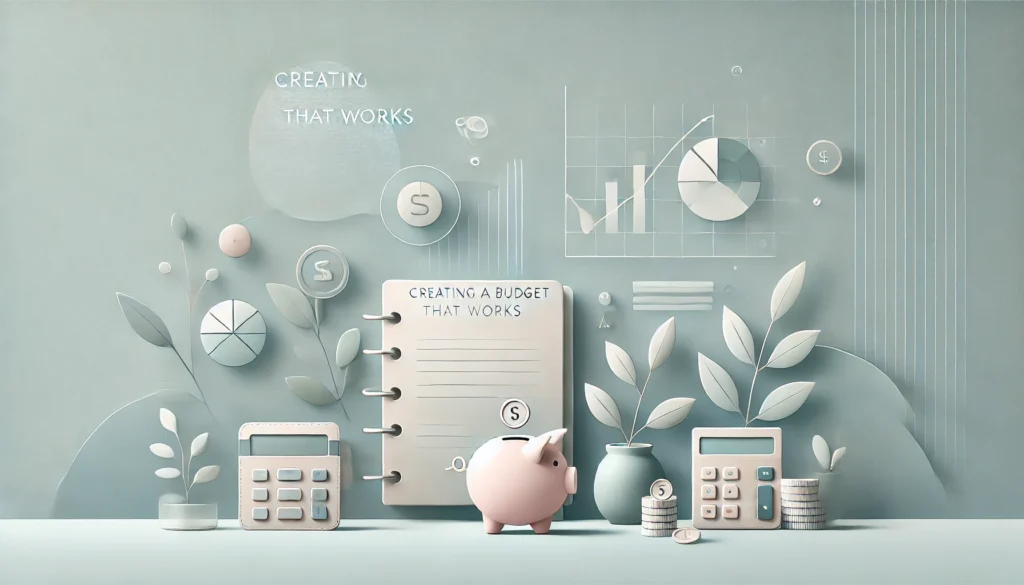Introduction
Learning how to create a budget that works for you is one of the best steps toward financial freedom. A well-structured budget lets you control your spending, build savings, and reduce debt effectively. This guide will walk you through everything you need to know to set up a personal budget tailored to your income, goals, and lifestyle. Whether you’re new to budgeting or looking for a budget makeover, this step-by-step approach can help you take charge of your finances and reach your money goals.
1. Why Budgeting is Important
Budgeting is essential for managing money wisely. Without a budget, it’s easy to lose track of spending and miss financial goals. A solid budget helps you:
- Control your spending
- Avoid unnecessary debt
- Save more consistently
- Achieve long-term financial security
Think of budgeting as your financial roadmap, guiding you toward financial stability and independence.

2. Set Clear Financial Goals
Setting specific financial goals is a critical first step in creating a budget. Clear goals give your budgeting purpose and help you stay focused. Typical goals might include:
- Building an Emergency Fund: A safety net for unexpected expenses.
- Saving for a Down Payment: A common goal for first-time homebuyers.
- Paying Off Debt: Reducing or eliminating credit card debt, student loans, or other liabilities.
- Saving for Retirement: Ensuring a secure future with investments like 401(k)s or IRAs.
Defining what you’re saving for will help you allocate your money effectively.
3. Calculate Your Monthly Income
To create an effective budget, start by calculating your monthly income. Include all sources of income:
- Take-Home Pay (after taxes and deductions)
- Freelance or Side Hustle Income: Any money earned outside your primary job.
- Investment Income: Dividends or interest from savings accounts, stocks, etc.
- Passive Income: Rental income, royalties, or online earnings.
Knowing your total income gives you a clear picture of how much you have to work with each month.
4. Track Your Monthly Expenses
A successful budget requires a thorough understanding of your monthly expenses. Tracking expenses shows where your money goes and highlights areas where you can cut back. Expenses generally fall into three categories:
- Fixed Expenses: Rent/mortgage, insurance, and loan payments.
- Variable Expenses: Groceries, utilities, gas—these can change month to month.
- Discretionary Spending: Non-essentials, such as dining out, entertainment, and streaming subscriptions.

5. Choose a Budgeting Method That Suits You
There are various budgeting methods to suit different lifestyles. Here are some popular options:
- 50/30/20 Rule: Allocate 50% of income to needs, 30% to wants, and 20% to savings and debt repayment.
- Zero-Based Budgeting: Assign every dollar a purpose until your income minus expenses equals zero.
- Envelope System: Set spending limits for categories by using envelopes (either physical or digital).
Trying out different budgeting methods will help you find the one that best fits your financial situation and spending habits.
6. Set Spending Limits and Stick to Them
Once you’ve chosen a budgeting method, set spending limits for each category. Here are a few strategies:
- Prioritize Essentials: Start by setting limits for rent, groceries, and utilities.
- Adjust Discretionary Spending: Lower dining, entertainment, or other non-essentials as needed.
- Keep It Realistic: Make sure your limits reflect your lifestyle, allowing flexibility to prevent budget burnout.
7. Automate Your Savings and Bill Payments
Automating savings and bill payments helps you stick to your budget. Set up automatic transfers to your savings account or emergency fund at the start of the month to ensure you’re paying yourself first. Automating bill payments can also help you avoid late fees and keep your budget consistent.
8. Review and Adjust Your Budget Regularly
Life changes—whether it’s a new job, a raise, or a big purchase. Reviewing and adjusting your budget every month helps keep it aligned with your financial situation. Check for areas where you’re overspending and see if any adjustments can bring you closer to your goals.
9. Quick Tips for Sticking to Your Budget
Budgeting can be challenging at first, but these quick tips can help you stay on track:
- Use Budgeting Apps: Tools like Mint, YNAB, and EveryDollar can simplify tracking and adjustments.
- Track Spending Daily: Monitor your expenses to avoid last-minute surprises.
- Reward Yourself: Celebrate small wins, like staying within budget, to stay motivated.
Sample Budget Template to Get You Started
To help you get started, here’s a sample monthly budget template:
| Category | Amount |
|---|---|
| Housing | $1,000 |
| Transportation | $200 |
| Groceries | $300 |
| Savings | $200 |
| Entertainment | $100 |
| Debt Repayment | $100 |
| Miscellaneous | $50 |
Conclusion: Start Your Budgeting Journey
A budget that truly works for you is the foundation of financial freedom. It’s not about limiting yourself; it’s about understanding your financial situation and making smart choices to achieve your goals. Whether you’re aiming to save more, pay off debt, or invest for the future, budgeting is a powerful tool to get you there.
